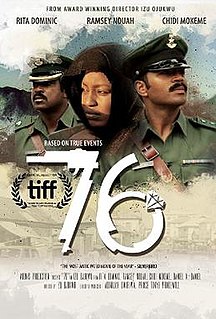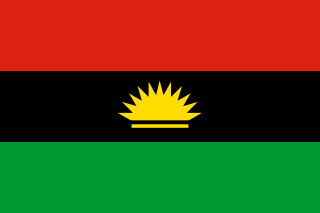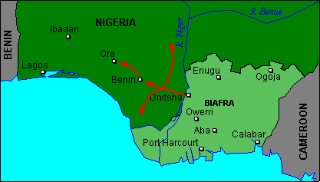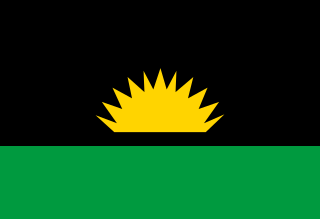 W
WThe Nigerian Civil War was a civil war fought between the government of Nigeria and the Republic of Biafra, a secessionist state which had declared its independence from Nigeria in 1967. Nigeria was led by General Yakubu Gowon, while Biafra was led by Lt. Colonel Odumegwu Ojukwu. Biafra represented the nationalist aspirations of the Igbo ethnic group, whose leadership felt they could no longer coexist with the federal government dominated by the interests of the Muslim Hausa-Fulanis of northern Nigeria. The conflict resulted from political, economic, ethnic, cultural and religious tensions which preceded Britain's formal decolonization of Nigeria from 1960 to 1963. Immediate causes of the war in 1966 included ethno-religious violence and anti-Igbo pogroms in Northern Nigeria, a military coup, a counter-coup and persecution of Igbo living in Northern Nigeria. Control over the lucrative oil production in the Niger Delta also played a vital strategic role.
 W
W’76, formerly Lions of ’76, is a 2016 Nigerian historical fiction drama film directed by Izu Ojukwu and produced by Adonaijah Owiriwa and Izu Ojukwu. It stars Ramsey Nouah, Chidi Mokeme, Rita Dominic, and Ibinabo Fiberesima.
 W
WThe Abagana Ambush was an ambush by Biafran guerrilla troops led by Major Jonathan Uchendu that wiped out the Nigerian 2 Division. Of the 6,000 Nigerian troops ambushed, only a very small number survived, including the 2nd Division's commander, General Murtala Muhammed.
 W
WThe Ahiara Declaration: The Principles of the Biafran Revolution, commonly known as the Ahiara Declaration, was a document written by the National Guidance Committee of Biafra and delivered as a speech by the Head of State of Biafra Emeka Ojukwu in the Biafra town of Ahiara on June 1, 1969.
 W
WBiafra, officially the Republic of Biafra, was a secessionist state in West Africa that existed from May 1967 to January 1970. Its territory consisted of the Eastern Region of Nigeria. Biafra was formed as a result of the nationalist aspirations of the Igbo people of Nigeria, leading to the Nigerian Civil War. Nigeria declared war on Biafra shortly after its declaration of independence, eventually defeating Biafra and reuniting the two states.
 W
WThe Biafra Story is a 1969 non-fiction book by Frederick Forsyth about the Nigerian Civil War (1967–70) in which Biafra unsuccessfully attempted to secede from Nigeria. Reportedly one of the earliest eyewitness accounts of the war from the Biafran perspective, a revised edition was published after the war in 1977.
 W
WThe Biafran Airlift was an international humanitarian relief effort that transported food and medicine to Biafra during the 1967-70 secession war from Nigeria. It was the largest civilian airlift and, after the Berlin airlift of 1948–49, the largest non-combatant airlift of any kind ever carried out. The airlift was largely a series of joint efforts by Protestant and Catholic church groups, and other non-governmental organizations (NGO)s, operating civilian and military aircraft with volunteer (mostly) civilian crews and support personnel. Several national governments also supported the effort, mostly behind the scenes. This sustained joint effort, which lasted one and a half times as long as its Berlin predecessor, is estimated to have saved more than a million lives.
 W
WHMS Montford was one of 23 boats of the Ford class of patrol boats built for the Royal Navy in the 1950s.
 W
WHMS Gifford was one of 23 boats of the Ford class of patrol boats built for the Royal Navy in the 1950s. Gifford was launched on 30 June 1954. In 1968 the vessel was sold to Nigeria and renamed NNS Bonny. Bonny took part in the Nigerian Civil War and was decommissioned in 1983. Bonny is preserved at the Nigerian War Museum in Umuahia.
 W
WThe First Invasion of Onitsha was a large military conflict between Biafran and Nigerian forces. The Nigerian 2nd Division managed to seize control of Onitsha for less than one day before being massacred by Biafran soldiers.
 W
WHMS Montford was one of 23 boats of the Ford class of patrol boats built for the Royal Navy in the 1950s.
 W
WThe Midwest Invasion of 1967 codenamed Operation Torch. was a military operation between Nigerian and Biafran military forces during the Nigerian Civil War. The invasion began on August 9 when 3,000 Biafran soldiers led by General Victor Banjo crossed the River Niger Bridge into Asaba. Upon reaching Agbor, the Biafrans split up. With the 12th Battalion moving west capturing Benin City and Ore, the 18th Battalion swung south, taking Warri, Sapele and Ughelli, while the 13th Battalion headed north for Auchi, Agenebode and Okene. Simultaneously, a plot to capture Mid-Western Governor David Ejoor at his home in Benin failed. Nevertheless, the Biafrans, meeting virtually no resistance, had seized the entire Mid-Western Region in less than 12 hours.
 W
WHMS Montford was one of 23 boats of the Ford class of patrol boats built for the Royal Navy in the 1950s.
 W
WOperation Hiroshima was a military operation conducted by the Biafran 4th Commando Brigade in an attempt to recapture Onitsha from the Nigerian 2nd Division. The operation ultimately resulted in failure and ended in the deaths of numerous mercenaries and Biafran soldiers.
 W
WOperation OAU was a battle between Nigerian 3 Marine Commando Division (3MCDO) and Biafran 12 Division in modern day south-eastern Nigeria. Operation OAU was an intermittent battle that may have resulted in over 25,000 deaths on both sides. Although the Biafran soldiers were outnumbered, they were able to retain control of Umuahia and eventually recapture the cities of Owerri and Aba.
 W
WThe Operation UNICORD was an offensive launched by the Nigerian Army at the beginning of the Nigerian Civil War. It involved the capture of 6 major Biafran towns near their northern border.
 W
WThe Republic of Benin was an ephemeral unrecognized secessionist state in West Africa which existed for one day in 1967. It was established on 19 September 1967 during the Nigerian Civil War as a puppet state of Biafra, following its occupation of Nigeria's Mid-Western Region, and named after its capital, Benin City, with Albert Nwazu Okonkwo as its head of government. The new state was an attempt by Biafra to prevent non-Igbo residents of the neighboring Mid-Western Region from siding with Nigeria following regional ethnic tensions early in the war. The Republic of Benin was officially declared even as the Nigerian federal forces were reconquering the region and ended the following day as they entered Benin City. The occupation of the Mid-Western Region turned residents against the secessionist cause, and was used by the Nigerian government as justification to escalate the war against Biafra.
 W
WThe Second Invasion of Onitsha was military conflict between Nigerian and Biafran military forces.